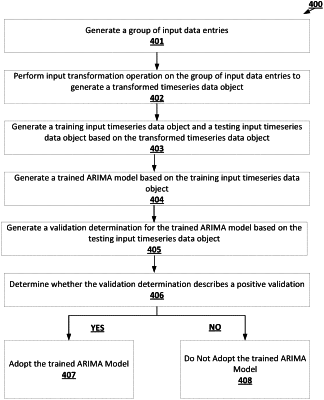| CPC G16H 50/80 (2018.01) [G06N 5/04 (2013.01); G06N 20/00 (2019.01)] | 20 Claims |

|
1. A computer-implemented method comprising:
identifying, by one or more processors, a seasonally-adjusted training input timeseries data object and a seasonally-adjusted testing timeseries data object for a superior time period within a monitored period, wherein the seasonally-adjusted training input timeseries data object is identified by replacing an outlier value corresponding to an inferior time period within the superior time period with an average value across one or more preceding inferior time periods corresponding to the inferior time period and preceding the superior time period;
updating, by the one or more processors, a trained autoregressive integrated moving average (ARIMA) machine learning model using the seasonally-adjusted training input timeseries data object by:
determining an optimal differencing order hyper-parameter of the trained ARIMA machine learning model that is configured to transform the seasonally-adjusted training input timeseries data object into a stationary seasonally-adjusted training input timeseries data object,
determining an optimal lag order hyper-parameter of the trained ARIMA machine learning model and an optimal moving average order hyper-parameter of the trained ARIMA machine learning model that are collectively configured to optimize a machine learning model utility measure for the trained ARIMA machine learning model, and
determining one or more optimal parameters of the trained ARIMA machine learning model that are configured to enable the trained ARIMA machine learning model to describe the seasonally-adjusted training input timeseries data object given the optimal differencing order hyper-parameter, the optimal lag order hyper-parameter, and the optimal moving average order hyper-parameter;
determining a validation determination for the trained ARIMA machine learning model based at least in part on the seasonally-adjusted testing timeseries data object; and
in response to the validation determination satisfying an accuracy measure threshold, enabling, by the one or more processors, performance of a predictive inference using the trained ARIMA machine learning model in order to generate one or more prospective time-lagged predictions and to perform one or more prediction-based actions based at least in part on the one or more prospective time-lagged predictions.
|